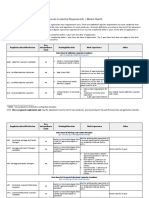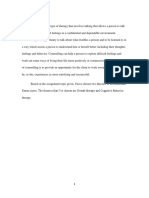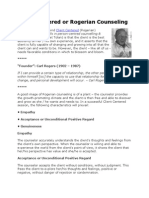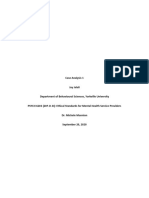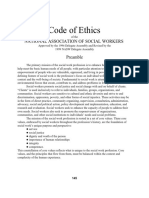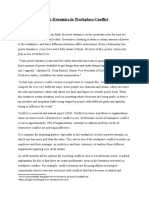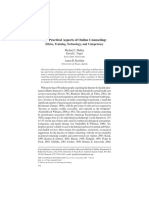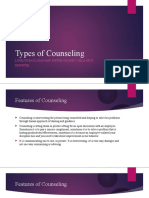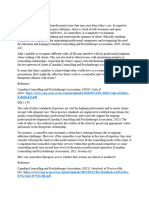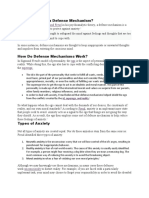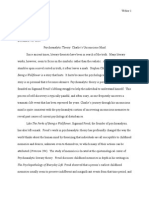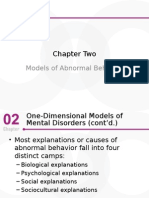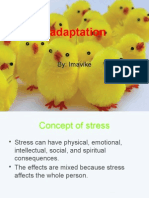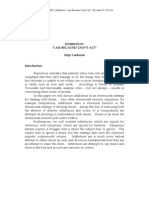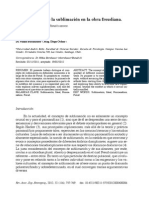Ethical Counselling Because counselling is not a regulated profession in many countries (including Australia), the use of ethical standards
is a method of guiding the quality of the services provided by counsellors, the quality of training provided to counsellors, and of protecting clients. These standards provide conduct guidelines for professionals and are an effective way support many counsellors lacking experience or knowledge of the industry. It also serves the purpose of structuring the counselling industry, providing common professional descriptions, definitions and service boundaries according to each type of counsellor. There is a wide range of issues comprising the field of ethical counselling - which are also part of common guidelines for the practice of therapy. According to Daniluk and Haverkamp (1993), "the main ethical framework referred to in many discussions of therapy is one based on the concepts of autonomy, fidelity, justice, beneficence, non-maleficence and self interest". In this context, we devise several 'problem areas' in ethical counselling: In Sigmund Freud's topographical model of personality, the ego is the aspect of personality that deals with reality. While doing this, the ego also has to cope with the conflicting demands of the id and the superego. The id seeks to fulfill all wants, needs and impulses while the superego tries to get the ego to act in an idealistic and moral manner. What happens when the ego cannot deal with the demands of our desires, the constraints of reality and our own moral standards? According to Freud, anxiety is an unpleasant inner state that people seek to avoid. Anxiety acts as a signal to the ego that things are not going right. Frued identified three types of anxiety: 1. Neurotic anxiety is the unconscious worry that we will lose control of the id's urges, resulting in punishment for inappropriate behavior. 2. Reality anxiety is fear of real-world events. The cause of this anxiety is usually easily identified. For example, a person might fear receiving a dog bite when they are near a menacing dog. The most common way of reducing this anxiety is to avoid the threatening object. 3. Moral anxiety involves a fear of violating our own moral principles. In order to deal with this anxiety, Freud believed that defense mechanisms helped shield the ego from the conflicts created by the id, superego and reality. Defense Mechanisms Because of anxiety provoking demands created by the id, superego and reality, the ego has developed a number of defense mechanisms to cope with anxiety. Although we may knowingly use these mechanisms, in many cases these defenses work unconsciously to distort reality.
�While all defense mechanisms can be unhealthy, they can also be adaptive and allow us to function normally. The greatest problems arise when defense mechanisms are overused in order to avoid dealing with problems. There are a number of defense mechanisms that have been described by researchers. Sigmund Freud's daughter, Anna Freud described ten different defense mechanisms used by the ego. Follow the links below to read more about each type of defense mechanism as well as other defense mechanisms described by psychologists. Next: Denial, Repression, and Suppression Denial is probably one of the best known defense mechanisms, used often to describe situations in which people seem unable to face reality or admit an obvious truth (i.e. "He's in denial."). Denial is an outright refusal to admit or recognize that something has occurred or is currently occurring. Drug addicts or alcoholics often deny that they have a problem, while victims of traumatic events may deny that the event ever occurred. Denial functions to protect the ego from things that the individual cannot cope with. While this may save us from anxiety or pain, denial also requires a substantial investment of energy. Because of this, other defenses are also used to keep these unacceptable feelings from consciousness. Repression is another well-known defense mechanism. Repression acts to keep information out of conscious awareness. However, these memories don't just disappear; they continue to influence our behavior. For example, a person who has repressed memories of abuse suffered as a child may later have difficulty forming relationships. Sometimes we do this consciously by forcing the unwanted information out of our awareness, which is known as suppression, but it is usually believed to occur unconsciously. Displacement If you have ever had a bad day at work, then gone home and taken out your frustration on family and friends, you have experienced the ego defense mechanism of displacement. Displacement involves taking out our frustrations, feelings and impulses on people or objects that are less threatening. Displaced aggression is a common example of this defense mechanism. Rather than express our anger in ways that could lead to negative consequences (like arguing with our boss), we instead express our anger towards a person or object that poses no threat (such as our spouses, children or pets). Sublimation is a defense mechanism that allows us to act out unacceptable impulses by converting these behaviors into a more acceptable form. For example, a person experiencing extreme anger might take up kick-boxing as a means of venting frustration. Freud believed that sublimation was a sign of maturity that allows people to function normally in socially acceptable ways.
�Projection is a defense mechanism that involves taking our own unacceptable qualities or feelings and ascribing them to other people. For example, if you have a strong dislike for someone, you might instead believe that he or she does not like you. Projection works by allowing the expression of the desire or impulse, but in a way that the ego cannot recognize, therefore reducing anxiety. Intellectualization works to reduce anxiety by thinking about events in a cold, clinical way. This defense mechanism allows us to avoid thinking about the stressful, emotional aspect of the situation and instead focus only on the intellectual component. For example, a person who has just been diagnosed with a terminal illness might focus on learning everything about the disease in order to avoid distress and remain distant from the reality of the situation. Rationalization is a defense mechanism that involves explaining an unacceptable behavior or feeling in a rational or logical manner, avoiding the true reasons for the behavior. For example, a person who is turned down for a date might rationalize the situation by saying they were not attracted to the other person anyway, or a student might blame a poor exam score on the instructor rather than his or her lack of preparation. Rationalization not only prevents anxiety, it may also protect self-esteem and self-concept. When confronted by success or failure, people tend to attribute achievement to their own qualities and skills while failures are blamed on other people or outside forces. When confronted by stressful events, people sometimes abandon coping strategies and revert to patterns of behavior used earlier in development. Anna Freud called this defense mechanism regression, suggesting that people act out behaviors from the stage of psychosexual development in which they are fixated. For example, an individual fixated at an earlier developmental stage might cry or sulk upon hearing unpleasant news. Behaviors associated with regression can vary greatly depending upon which stage the person is fixated at:
An individual fixated at the oral stage might begin eating or smoking excessively, or might become very verbally aggressive. A fixation at the anal stage might result in excessive tidiness or messiness.
Reaction formation reduces anxiety by taking up the opposite feeling, impulse or behavior. An example of reaction formation would be treating someone you strongly dislike in an excessively friendly manner in order to hide your true feelings. Why do people behave this way? According to Freud, they are using reaction formation as a defense mechanism to hide their true feelings by behaving in the exact opposite manner.
Since Freud first described the original defense mechanisms, other researchers have continued to describe other methods of reducing anxiety. Some of these defense mechanisms include:
Acting out - The individual copes with stress by engaging in actions rather than reflecting upon internal feelings. Affiliation - Involves turning to other people for support. Aim inhibition - The individual accepts a modified form of their original goal (i.e. becoming a high school basketball coach rather than a professional athlete.) Altruism - Satisfying internal needs through helping others. Avoidance - Refusing to deal with or encounter unpleasant objects or situations. Compensation - Overachieving in one area to compensate for failures in another. Humor - Pointing out the funny or ironic aspects of a situation. Passive-aggression - Indirectly expressing anger.
While defense mechanisms are often thought of as negative reactions, some of these defenses can be helpful. For example, utilizing humor to overcome a stressful, anxiety-provoking situation can actually be an adaptive defense mechanism. Maladaptive Use Defense mechanisms are helpful and healthy if used in a proper manner. However, if misused or overused, the same defense mechanisms may also be unhealthy. Maladaptive use of defense mechanisms can occur in a variety of cases, for example when they become automatic and prevent individuals from realizing their true feelings and thoughts. Frequent or continuous use of defense mechanisms disrupts reality-testing. Denial and paranoid projection are considered to be psychotic in nature, as their repeated use can cause people to lose touch with the real world and their surroundings, and consequently isolate themselves from reality and dwell in a world created of their own design. Defense mechanisms can also be harmful if:
There are too few defenses that can be employed in coping with threats; There is too much superego activity, which causes the use of too many defenses.
Conclusion There are two main ways for a person to cope with threats: 1. avoiding, repressing, denying, looking away, escaping from the situation, or letting someone else take the blame; 2. approaching, learning more, and taking charge. The first method may include the use of defense mechanisms such as denial, repression/suppression, withdrawal, or projection. The second method may involve use of the defense mechanisms of rationalization, sublimation, identification, compensation, and undoing. However, approaching and taking charge of the situation may still be done in unhealthy ways.
�Generally, the first way reduces stress, while the second increases chances for coping with the situation. Thus, the first way is more effective when the situation is beyond our control, the second way works when there is something that can be done about the problem. Most people use both ways depending on the situation, but also tend to have a preferred way. Each has its own disadvantages: more stress and worry for the "approachers" and lack of awareness for the "avoiders." Freud saw defense mechanisms as necessary, but he considered most of them negative, the only positive one being sublimation. Many researchers continued with this view, declaring that most of the defense mechanisms involve lies, and the only thing they doespecially if used continuallyis to create more problems. The main problem with defense mechanisms is that if they are used for the long time, they may become automatic and separate a person from their true feelings and from reality. However, as has been seen, sublimation, suppression, undoing, and identification can be used in a healthy way to help solve problems. Other mechanisms that may be helpful in short-term adaptation to a particular situation (but not healthy in the long run) are intellectualization, repression, displacement, and dissociation. Defense mechanisms are neither good nor bad in themselves. It all depends on how, and for how long, they are being used. Defense mechanisms are often needed, and used, to protect ones self from pain. However, usually this is a temporary solution, and eventually one comes to the point when they have to face the real situation. If an individual refuses to do so, they cross the very thin line between healthy and unhealthy use of this psychological "painkiller," in the same way that a patient may become addicted to medical painkillers used to treat physical pain. The ultimate solution, though, is to address the origin of the pain, and in the case of psychological pain it is to be hoped that future human societies will have the understanding and capability of caring for and nurturing all their individual members in such a way that defense mechanisms are no longer necessary. Characteristics of a "good" theory 1. A theory is better if it accurately reflects the facts of the real world. 2. A theory is better if it is stated in a way that makes it clearly understandable to anyone who is reasonably competent. 3. A theory is better if it not only explains the past, but helps predict the future with specifics. 4. A theory is better if it offers practical guidance in solving daily problems. 5. A theory is better if it is internally consistent (should fit together logically). 6. A theory is better if it is economical in the sense there are as few unproven assumptions as possible and it explains as much as possible (law of parsimony). 7. A theory is better if it is falsifiable or disconfirmable. 8. A theory is better if it stimulates new knowledge. 9. A good theory is one that makes good sense.
�Adapted from Comparing Theories of Child Development (4th edition), by R. Thomas
ETHICAL & LEGAL ISSUES IN COUNSELING
Counselors, like all professionals, have ethical responsibilities and obligations. The principal rule supporting ethical obligations is that the counselor must act with full recognition of the importance of clients rights, the ethics of the profession. Counseling is not a value-free or neutral activity (Grant, 1992). It is a profession based on values, which are orienting beliefs about what is goodand how that good should be achieved (Bergin, 1985), the relationship of moral standards and values, individual or cultural, in the life of that client.
Ethical Codes
Ethics are suggested standards of conduct based on a consensus value set. Ethical standards are generally formalized in terms of a code of ethics. As the group emerges in its development toward professionalism, it requires formulation of code of ethics for safe practice of the profession. Professional bodies of counseling have developed ethical standards which they have made available to the practitioners. Professional organizations for practicing counseling and psychotherapy are: American Psychological Association (APA) British Association for Counseling (BAC) American Counseling Association (ACA)
In each case, members who were directly involved in writing the code reviewed and examined a wide range of ethical behavior and problems of professional practice that were of concern to a broadly based membership. All codes stress adherence to rigorous professional standards and to exemplary behavior, integrity, and objectivity toward clients. Development of Codes
APA Code: Two codes of ethics guide counselors for the practice of ethical counseling:
a. o General Code of Ethics, Ethical Principles of Psychologists, can also be applied to the practice of counseling. On violation appropriate action is taken, which includes dismissal from the membership. b. o In the Specialty Guidelines for the Delivery of Services by Counseling Psychologists, APA has printed a casebook for the service providers.
ACA Code: Codes of Ethics & Standard of Practice ACA also provide a casebook containing 8 major sections.
�1. o Based its first standards on APA code of ethics, this code does not contain any classification of misbehavior nor does it attach penalties to the violation of the standards. 2. o Initiated by Donald Super and approved in 1961. 3. o These standards focus on guidelines for professional conduct. 4. o The fundamental rule is that the human being must be respected and protected at all times, which can be done only by counselors who manifest honesty, integrity, and objectivity in their behavior toward their clients. Unethical behavior usually occurs when the counselor communicates in a way that establishes one set of expectations and then behaves in a way that is inconsistent with those expectations. For example, the counselor structures the counseling situation verbally or nonverbally to imply mutual trust, concern, and confidentiality. The counselor then behaves in a way that upsets these expectations because the counselor then assigns greater value to another societal role. Reasons for Ethical Codes Help professionalize and protect an association by government and promote stability within the profession.
Help control internal disagreement. Protect practitioners from the public. Protect clients from incompetent counselors especially in malpractice issues. Clients can also use codes to evaluate questionable treatment from the counselor.
Unethical Behavior Unethical behavior can take many forms:
Violation of confidentiality. Exceeding ones level of professional competence: Competence refers to the ability to perform effectively. Therapists must limit their service to their training and experience. Claiming expertise one does not possess relates to the violation of this ethical standard. Imposing ones values on a client. Creating dependency in a client. Certain conflicts of interest: No multiple or dual relationships are allowed, for example it is unethical for a therapist to have a sexual or business relationship with the patient outside the therapeutic relationship. Questionable financial arrangements such as drawing excessive fees. Improper advertising regarding ones potentials or credentials.
Client Rights: Informed Consent
Involves the rights of clients to be informed about what their relationships with the counselor will entail and to make autonomous decisions. Starts with intake interview and continues for the duration of the relationship. Usually comprehensive written statements are used (ACA Code of Ethics).
�Client Rights: Confidentiality
Confidentiality is considered as a central concept in the client-helper relationship. The greatest single source of ethical dilemma in counseling results from questions of confidentiality. Confidentiality needs to be discussed with clients from the onset of the relationship. Minor or incompetent clients: Counselors act in the best interest of those unable to give voluntary consent. Records: Provide access to records when requested by clients Disclosure of transfer Permission to record Anonymity in research Respect for privacy in consultation
Principles Govern Confidentiality Schneiders (1963) terms the information revealed in counseling an entrusted secret He provided seven general principles governing confidentiality and communication:
Obligation of confidentiality is relative rather than absolute since there are conditions which can alter it. Confidentiality depends on the nature of the material. Harmless material does not bind the counselor to confidentiality. Material necessary for a counselor/agency to function effectively is often released from the bonds of confidentiality. Intrinsic right of the counselee to his integrity and reputation: Confidentiality is always conditioned by the intrinsic right of the counselee to his integrity and reputation, to the secret, and to resist aggression. Such rights can be protected by the counselor even against the law. Confidentiality is also limited by the rights of the counselor to preserve his own reputation and integrity, to resist harm or aggression, and to preserve privileged communication. Limited by the rights of an innocent third party/community.
Limitations of Confidentiality: a.Suspected child abuse must be reported. b.Threats to harm others must be reported. Rationale for Confidentiality: Need for balance between the rights of the individual and the safety of society (Denkowski & Denkowski, 1982) with specific attention to the importance of counselors keeping up-to-date with the legal status of confidentiality.
In special circumstances, it is the Duty to warn whenever the counselor has reasonable knowledge that a clients conduct may be harmful to self or to another (Gehring, 1982).) Professionals inform clients of the limits of confidentiality prior to the onset of helping relationship (National Organization for Human Service Education, 1995).
Obligations to Warn & Protect In the case of special circumstances, it is the obligation of the counselor to warn the related people/ family members. A few examples are given below:
Incest and Child abuse Serious danger to others: e.g., in case of HIV-positive client. This as a new standard was added in 1995 in ACA code of ethics. The case of Tarasoff v. Board of Regents of the University of California (1969) is a famous example when the California Supreme Court ruled that the University and its employees acted in an irresponsible manner when they failed to notify an intended victim of a threat, resulting in the victims murder. Runaway plan of a child client must be reported to the parents. Students violation of confidentiality. Harm-to-self: Most suicides can be prevented if we learn to recognize, evaluate, and intervene effectively in crises situations (Fujimura et al., 1985). Wubbolding (1996) suggests a few questions to identify danger, for example, usually suicidal look hopeless; this knowledge can be used to detect such cases.
Client Rights: Respecting the Clients Autonomy and Diversity Following problems can occur, if clients rights for freedom are not respected:
Fostering dependence in clients Counselor having a hard time terminating a case Challenging clients to do for themselves what they are unable to do Keeping helping process mysterious Discrimination





